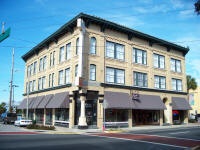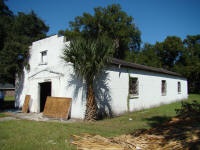Eustis is one of several towns in Lake County dating to the 1870s, a post Civil War era when settlers moved southward from other states into the Florida frontier. Eustis is named after Colonel Abraham Eustis who served in the U.S. Army in Florida during the early nineteenth century. Settlement at Eustis began in late 1875, with the arrival of several homesteaders including A.S. Pendry, who became the postmaster of the Pendryville post office in 1877.
In 1879, Pendry platted 80 acres of his homestead as Pendryville; the name was soon changed to Lake Eustis, and then to simply Eustis. Before railroads reached central Florida, long distance travel and shipping relied on steamboats and early settlements were concentrated along navigable waterways. Steamboats along the St. Johns River connected Eustis with Mellonville (today Sanford) and Jacksonville. In Eustis, a boat landing on the lake at the foot of Macdonald Avenue was the primary shipping point, and established that street as a commercial corridor.

With the arrival of the St. Johns and Lake Eustis Railway in 1880, replacing steamboats as prevalent mode of transportation and shipping, the frontier settlement of Eustis grew into a small city, with churches, stores, schools, a bank, and a newspaper. Residents voted to incorporate Eustis in 1883. Citrus growing was a major industry in Eustis. The Big Freeze of 1894-95 and 1898-99 devastated the citrus crop in Eustis and the surrounding areas. Despite this setback and subsequent freezes, the citrus industry continued to flourish and Eustis became known as the “Orange Capital of the World.” The United States Department of Agriculture had even established a research station and laboratory in Eustis used to study plant diseases and later “became involved in pioneer research of hybridization of citrus.
In addition to the fruit and vegetables grown by local farmers, the town’s economy included tourism. Hotels (the largest being the Ocklawaha Hotel), boating, parks, and clubs attracted visitors during the temperate winter months.
The efficiency of the railroad over steamboat and horse and carriage travel made travel more desirable and the number of people traveling to Eustis increased. Tourists coming to Eustis by train would arrive at the Atlantic Coast Line Railroad Depot which formerly stood at the southwest corner of Magnolia Avenue and Bay Street. Later, in the 1910s, the Dixie Highway and paved roads brought automotive tourists to Eustis.
One of the popular past times on Lake Eustis was motor boating. It was written in newspapers that this sport could not be matched in any other section of the state. Boating on Lake Eustis has remained a great attraction for tourists and residents.
Ferran Park was the City’s first public park. It is named after Eustis pioneer and local businessman Edgar L. Ferran. The park began with the purchase of land between Clifford Avenue and Orange Avenue in 1913.
A bulkhead (a concrete retaining wall) was constructed 250 feet out into Lake Eustis and extended approximately 950 feet along the shoreline. Once, the bulkhead was complete it was filled with sand from the bottom of Lake Eustis to create the park that we have today.
 Seeing an opportunity to serve the tourists, Frank D. Waterman, of the Waterman Fountain Pen Company, built the Fountain Inn, a first-rate hotel in downtown Eustis. The hotel opened in 1923 and operated up until 1936 when the impacts of the Great Depression could not be endured any further. In 1937 Mr. Waterman turned the hotel over to a group of local doctors for use as a hospital which “became known as the Waterman Memorial Hospital in honor of its benefactor. Florida Hospital Waterman, as it is called today, operated in the heart of downtown Eustis for over 65 years before relocating in 2004 to its current location on U.S. Hwy. 441.
Seeing an opportunity to serve the tourists, Frank D. Waterman, of the Waterman Fountain Pen Company, built the Fountain Inn, a first-rate hotel in downtown Eustis. The hotel opened in 1923 and operated up until 1936 when the impacts of the Great Depression could not be endured any further. In 1937 Mr. Waterman turned the hotel over to a group of local doctors for use as a hospital which “became known as the Waterman Memorial Hospital in honor of its benefactor. Florida Hospital Waterman, as it is called today, operated in the heart of downtown Eustis for over 65 years before relocating in 2004 to its current location on U.S. Hwy. 441.
In 2013, Eustis continues to revitalize itself and features a new downtown streetscape. Traditions are also maintained like our Washington Birthday Celebration (now named GeorgeFest), began in 1902 and has continued every year since then. Eustis remains a place of Culture, Opportunity, and Vitality!
Creating a superior quality of life by engaging and partnering with the community to provide financially prudent and customer friendly service.
Eustis City Hall

10 N. Grove Street (c. 1923 and 1927):
Eustis City Hall was constructed in two phases completed circa 1923 and 1927. This building, on the local level, has cultural and historical significance in the development of Eustis from its early days up until present times. City Hall is the center of city government and once included the library, fire department, police department, jail, and rooms for various organizations’ civic engagements. Even though many of these functions have moved to new locations as the City has grown, the building still maintains it original use as the center of local government. City Hall was designed by Alan J. MacDonough in the Classical Revival style of architecture. (Local Landmark status granted 2010).
Clifford House (Historical Museum)
 536 N. Bay Street (c. 1910):
536 N. Bay Street (c. 1910):
This structure is named for G.D. Clifford and his family. Mr. Clifford arrived inEustis in 1875. He was a local merchant, businessman, and civic participant. The Clifford House served as a private residence until 1983 when it became home to the Eustis Historical Museum & Preservation Society. This neo-classical style house provides a true step back into time and is a significant reminder of early Eustis. The Clifford House is listed on the National Register of Historic Places. (Local Landmark status granted 2010).
Alice B. McClelland Memorial Bandshell
 200 Ferran Park Drive (c. 1926):
200 Ferran Park Drive (c. 1926):
The bandshell was financed by William S. McClelland a local banker, businessman, and civic leader. He constructed the bandshell in honor of his wife, Alice, and donated it to the City. The fact that the bandshell is located in Ferran Park, the first public park in Eustis circa 1918, adds to the historical, cultural, and social context in which the bandshell was built and used. The bandshell was designed by Alan J. MacDonough in the Mediterranean Revival style of architecture. The structure is a good example of parabolic acoustical design and one of the two remaining historic bandshells in Florida. The Alice B. McClelland Memorial Bandshell is listed in the National Register of Historic Places. (Local Landmark status granted 2010).
Eustis Women's Club
 227 N. Center Street (c. 1930):
227 N. Center Street (c. 1930):
This building is significant on the local level for its association with the Eustis Woman's Club, a social and civic organization that has been active since 1902. In 2009 the Eustis Woman’s Club donated their building to the City, however, the club continues to meet at this location. The Eustis Woman's Club building was designed in the Neo-Classical style of architecture by Alan J. MacDonough, a local architect who also designed the Eustis City Hall building in the same style. The Eustis Woman’s Club building is listed on the National Register of Historic Places. (Local Landmark status granted 2010).
Grand Magnolia Inn
 108 N. Bay Street (c. 1912):
108 N. Bay Street (c. 1912):
This building first opened as the First State Bank in 1913 and was known as the “McClelland Building” after the bank’s president – William S. McClelland. Located in a prominent location in downtown, this building exhibits typical downtown development with commercial on the ground floor and residential on the upper floors. The most notable thing about the Grand Magnolia Inn is its Italianate style of architecture, which is not very common in the south. The structure has wonderful brickwork and is perhaps the most ornate building in the downtown area.The Grand Magnolia Inn is a contributing structure in the Eustis Historic Commercial District which is listed on the National Register of Historic Places. (Local Landmark status granted 1999).
Gethsemane Baptist Church
 535 S. Bay Street (c. 1914):
535 S. Bay Street (c. 1914):
The Gethsemane Missionary Baptist Church was founded in 1884. The current church was built on this location in 1914. This masonry vernacular structure has Gothic style fixed stained glass windows and a notable corner tower with battlements that form an angled entry. The Gethsemane Baptist Church has significant cultural history as one of the early African American Churches in Eustis. (Local Landmark status granted 2000).
Iron Block Building
 113 – 119 N. Bay Street and 112 McCulloch’s Alley (c. 1881):
113 – 119 N. Bay Street and 112 McCulloch’s Alley (c. 1881):
As the oldest commercial building still standing in Eustis, the Iron Block building exhibits the traditional style of downtown development with commercial on the bottom floor and residential on the upper floors. The Iron Block building is a three story building. The ground floor has a brick facade while the upper floors have a stucco exterior. Pedimented hoods adorn the windows on the second story. The Iron Block building is a contributing structure in the Eustis Commercial Historic District which is listed on the National Register of Historic Places. (Local Landmark status granted 1998).
Crazy Gator’s Restaurant
 402 N. Bay Street (c. 1928):
402 N. Bay Street (c. 1928):
Originally the Eustis Feed, Seed, and Supply Co., this structure has been home to several types of businesses over the years including a motorcycle shop in the 1970s and current use as a restaurant. This masonry vernacular structure has a notable stair stepped parapet façade and continues to contribute to the economic vitality and development of the downtown area. (Local Landmark status granted 2000).
Ace Theater
 1609 E. Bates Avenue (c. 1945):
1609 E. Bates Avenue (c. 1945):
In 2010, the Ace Theater collapsed which resulted in the demolition of this structure. The significance of Ace Theater is its place in history as the only theater built for African-American moviegoers in Eustis. Ace Theater is a significant and symbolic reminder of African-American heritage and culture within the City from the days of segregation to integration. This structure was a simple masonry vernacular building featuring a stair stepped façade. The interior had a concrete floor which sloped toward the stage area. (Local Landmark status granted 2001).
The Ferran House
310 East Orange Avenue (c. 1908): 
Once home to E.L. Ferran, the "Grand Old Man of Eustis" and namesake of Ferran Park. Was home to several generations of the Ferran family members. Was listed on the National Register of Historic Places on October 16, 2019.
Mt. Olive Cemetery
 Huffstetler Road (c. 1909):
Huffstetler Road (c. 1909):
Mt. Olive Cemetery maintains significant cultural heritage as an Africa-American Cemetery. The original 5 acres of the cemetery was purchased in 1909 for the sum of $50. Today the site is approximately 10 acres and was incorporated into the City limits in 1991. Prior to Mt. Olive Cemetery, African-American residents were buried in the northeast corner of Greenwood Cemetery in Eustis. It is noted that Mt. Olive Cemetery was originally called Mt. Homer Cemetery. (Local Landmark status granted 2004).